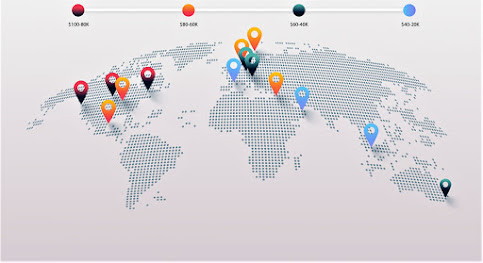Taxi App Development: Feature, Challenges And Cost
The taxi business is a very competitive industry; this is why taxi app development is widely popular. Many taxi app businesses, start-ups and even enterprises have invested in taxi app development to improve their workforce mobility and convenience.
Taxi app development has suppressed
traditional taxi services, now people can easily book taxi services by just
clicking on their smartphones. In recent years, taxi booking apps have made
progress, which is why their widespread availability in app stores, Uber and
taxi booking apps have made travelling more convenient than before.
The global taxi market is predicted to rise
by 12.3% between 2020 and 2027 from
its present value of $69.18 billion to $120.89 billion. According to the
forecasts, it is predicted to reach USD 327.54 billion by 2026, representing an
annual growth rate of 8.95% over the past years.
So, now is the most valuable time for
businesses to invest in taxi app development to enjoy the benefits of greater
productivity and profitability.
In this blog, we shall be discussing
features and tech stack for taxi app development, common challenges start-ups
face while developing taxi apps and the cost to develop a taxi app.
Features & Tech Stack for the
Taxi App Development
When you create your own taxi app, the driver and ride experiences should be
hassle-free as possible. For this you have to make sure, you include the necessary
features while developing your taxi app and take care of the tech stack you
choose because it will affect the cost of development.
Here is the list of necessary features for
taxi apps such as:
1.
Payment systems
The payment feature is the most crucial
feature of the taxi booking app development there should be an option for
making payments in advance. Additionally, mobile banking, e-wallets everything
should be available to the customers.
2.
Geolocation
With this feature, the driver and the user
will be able to see precisely the location and riders have options of places
where they want to be picked up and dropped off. On the other hand, drivers get
the pickup request via., geolocation which they can decide to pick up or drop
off.
3.
Keeping track
After starting the ride, users can easily
view the location on their smartphone and the cab can be monitored all the time
which makes consumers travel in a safe environment.
Moreover, users can easily cancel the ride
or report to customer care if the taxi is travelling to another route.
4.
Push notifications
Push notifications are great for giving
information about the offers to the customers. Using this function will help
you with brand promotion and methods of keeping your business running well.
5.
Security
A secure ride is the first thing that comes
to mind while booking a taxi ride. These features help with driver’s names,
phone numbers and taxi numbers shown on taxi booking software. Although
companies provide services which are secured while travelling with a stranger.
6.
Ratings
This feature is helpful for both drivers
and passengers as they can give a rating and write reviews about the ride which
helps improve taxi app services.
While hiring taxi app development services ask them to include these features in your
taxi app. Let’s look at the tech stack for taxi app development in the next
section.
Tech stack for Taxi app development:
|
Programming
Language |
Java, Kotlin, Swift, Python |
|
Database |
MySQL, MongoDB, Cassandra |
|
Backend
Framework |
Node.js, Ruby on Rails, Laravel |
|
Cloud Hosting |
Amazon Web Services (AWS), Google Cloud Platform
(GCP) |
|
Real-time
tracking |
Google Maps API, Mapbox |
|
Payment
Gateway Integration |
Stripe, PayPal, Braintree, Razor pay |
|
Push
Notifications |
Firebase Cloud Messaging (FCM) |
|
Analytics |
Google Analytics |
You have to choose this tech stack
according to your project requiremnts because it can affect the overall cost of
the taxi booking app. Before you start your taxi booking app let’s look at the
common challenges you face while developing a taxi app.
Common challenges while developing a taxi
app
If you are willing to create Uber like taxi app development here are
some common challenges faced during the development process include:
1.
Integration with
third-party services
Taxi apps often rely on third-party
services, such as payment gateways, GPS tracking, and mapping services.
Integrating these services into the app can be challenging, so make sure you
hire a taxi app developer that can integrate third-party services easily.
2.
User experience design
A taxi app must be intuitive and easy to
use, which requires careful user experience design. Developers must consider
the app's user flow, interface design, and interactions to ensure that users
can quickly and easily book a ride, track their driver's location, and pay for
their trip.
3.
Security and privacy
concerns
The
taxi app collects sensitive user data, such as location information, payment
details, and personal information. Ensuring the app's security and privacy is a
critical challenge for taxi booking app
developers.
4.
Driver management
Managing the fleet of drivers and ensuring a
smooth flow of communication between the driver and the user is crucial for the
success of a taxi app.
Moreover, developers must create a robust
driver management system that enables drivers to accept or reject ride
requests, update their location, and communicate with users.
5.
Continuous updates and
maintenance
A cab
booking app development requires continuous updates and maintenance to
ensure that it remains compatible with new operating system versions, security
updates, and feature enhancements.
Also, developers must be prepared to
release regular updates and fixes to keep the app running smoothly and maintain
user trust.
When you start your taxi app development just make sure you consult with a mobile app
development company about the cost before you start your taxi booking app
development.
Cost to develop a taxi app
The cost to start uber like taxi app development can vary widely depending on several
factors, such as the complexity of the app, the features included, the platform
it is developed for, and the location and experience level of the development
team.
In general, the development cost of a taxi
app can range from $20,000 to $100,000 or more.
Here is a breakdown of the estimated costs
for each stage of development:
·
Planning and design stage
This stage
involves defining the project requirements, creating a wireframe, designing the
UI/UX, and producing a prototype. The cost for this stage can range from $5,000
to $15,000.
·
Development stage
This stage involves developing the front-end
and back-end of the app, integrating APIs, creating a database, and testing the
app. The cost for this stage can range from $15,000 to $50,000.
·
Launch and maintenance stage
This stage
involves publishing the app on app stores, marketing and advertising the app,
and maintaining and updating the app. The cost for this stage can range from
$5,000 to $20,000 per year.
Note that these are just rough estimates
the actual cost can vary depending on the specifics of your project.
Additionally, ongoing costs such as server fees, payment processing fees, and
marketing expenses should also be considered while calculating the cost.
Conclusion
It is easy to create a taxi booking app like uber when you have an experienced team of
developers by your side. All you have to maintain proper communication with the
development team so that your taxi can be developed without any bugs and
errors.
We hope that this blog is helpful for you
to start your taxi app development. It is recommended to consult the cost with
a taxi app development company before you invest in the competitive niche.



Comments
Post a Comment